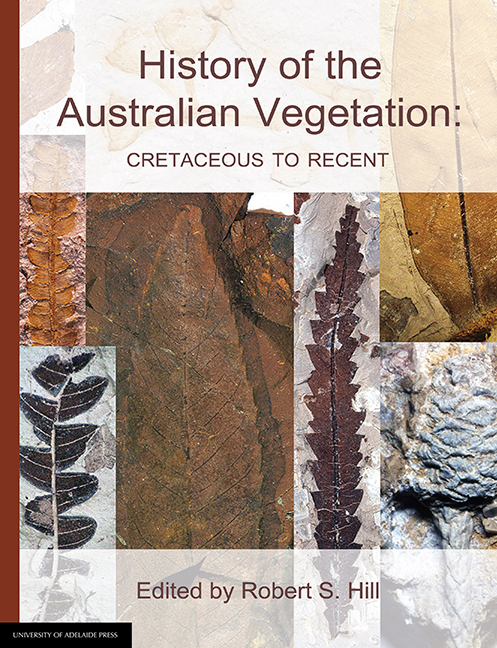Book contents
- Frontmatter
- Contents
- List of contributors
- Introduction to the 2017 edition
- 1 The Australian fossil plant record: an introduction
- 2 Maps of late Mesozoic-Cenozoic Gondwana break-up: some palaeogeographical implications
- 3 The background: 144 million years of Australian palaeoclimate and palaeogeography
- 4 Palaeobotanical evidence for Tertiary climates
- 5 Landscapes of Australia: their nature and evolution
- 6 Patterns in the history of Australia's mammals and inferences about palaeohabitats
- 7 Australian Tertiary phytogeography: evidence from palynology
- 8 Cretaceous vegetation: the microfossil record
- 9 Cretaceous vegetation: the macrofossil record
- 10 Early Tertiary vegetation: evidence from spores and pollen
- 11 The early Tertiary macrofloras of continental Australia
- 12 Cenozoic vegetation in Tasmania: macrofossil evidence
- 13 The Neogene: a period of transition
- 14 The Oligo-Miocene coal floras of southeastern Australia
- 15 Quaternary vegetation
- 16 The history of selected Australian taxa
- Taxonomic index
- General index
4 - Palaeobotanical evidence for Tertiary climates
Published online by Cambridge University Press: 25 July 2017
- Frontmatter
- Contents
- List of contributors
- Introduction to the 2017 edition
- 1 The Australian fossil plant record: an introduction
- 2 Maps of late Mesozoic-Cenozoic Gondwana break-up: some palaeogeographical implications
- 3 The background: 144 million years of Australian palaeoclimate and palaeogeography
- 4 Palaeobotanical evidence for Tertiary climates
- 5 Landscapes of Australia: their nature and evolution
- 6 Patterns in the history of Australia's mammals and inferences about palaeohabitats
- 7 Australian Tertiary phytogeography: evidence from palynology
- 8 Cretaceous vegetation: the microfossil record
- 9 Cretaceous vegetation: the macrofossil record
- 10 Early Tertiary vegetation: evidence from spores and pollen
- 11 The early Tertiary macrofloras of continental Australia
- 12 Cenozoic vegetation in Tasmania: macrofossil evidence
- 13 The Neogene: a period of transition
- 14 The Oligo-Miocene coal floras of southeastern Australia
- 15 Quaternary vegetation
- 16 The history of selected Australian taxa
- Taxonomic index
- General index
Summary
Climate is the primary framework within which plant populations grow, reproduce and, in the longer time frame, evolve. However, reconstructions of palaeoclimate are often based on the marine record (e.g. Quilty, 1984 and Chapter 3, this volume) or on computer modelling (Sloan & Barron, 1990). The latter type, in particular, suffer from their dependence on simplified scenarios and must be tested against the terrestrial palaeontological record. Individual species and whole plant communities are morphologically and physiologically adapted to their physical environment, most strongly to climate, and so plant macrofossils are a proxy record of past climates (Wolfe, 1971, 1985; Upchurch & Wolfe, 1987). Several studies have indicated that plant macrofossils provide a potentially accurate record of Tertiary terrestrial palaeotemperatures (Wolfe, 1979, 1990; Read et al, 1990). Interpretation of the climatic signal preserved in plant fossil assemblages is dependent on understanding (1) how plants (and vegetation) interact with climate, (2) how plant fossil assemblages were formed, and (3) how these assemblages relate to the original vegetation.
The use of terms such as tropical, subtropical and temperate in palaeoclimatic discussions is potentially confusing, as these terms are rarely defined climatically and have geographical (latitudinal) connotations that are inapplicable for much of the Tertiary. Following Wolfe (1979, 1985; Upchurch & Wolfe, 1987), the terms megathermal, mesothermal and microthermal are used here to describe the temperature characteristics of the vegetation of the main climatic zones. The definitions of Nix (1982; Kershaw & Nix, 1988) are used here, although Wolfe's (1979, 1985) vegetation classification uses slightly different definitions.
This discussion is restricted to the Tertiary, since pre-Tertiary floras are dominated by plant groups with no or few modern analogues and so palaeobotanical indices of climate are (as yet) unreliable. Numerous accounts of the Tertiary climate history of Australia based on palaeobotanical evidence have been published (Kemp, 1978, 1981; Christophel, 1981, 1988; Nix, 1982; Truswell & Harris, 1982; Christophel & Greenwood, 1989), in some cases as part of global accounts (Axelrod, 1984; Wolfe, 1985). Many of these interpretations have been based solely on nearestliving- relative analogy (NLR) and provide qualitative reconstructions of climate.
- Type
- Chapter
- Information
- History of the Australian VegetationCretaceous to Recent, pp. 44 - 59Publisher: The University of Adelaide PressPrint publication year: 2017



